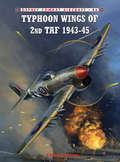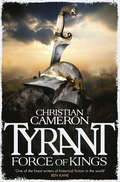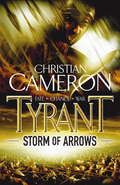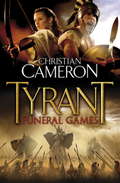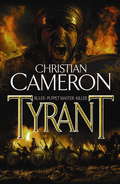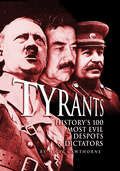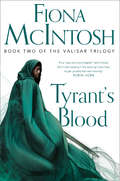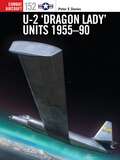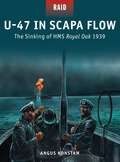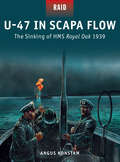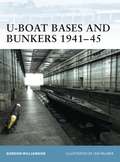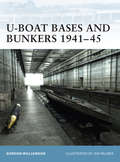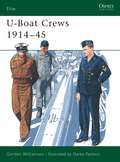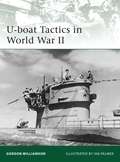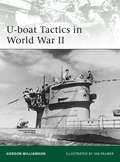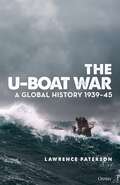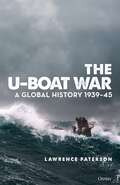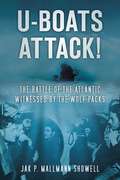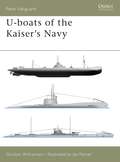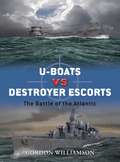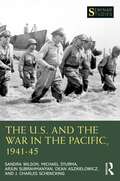- Table View
- List View
Typhoon Wings of 2nd TAF 1943–45 (Combat Aircraft #86)
by Chris ThomasThe Typhoon was the RAF's heavyweight fighter-bomber of choice to support the British and Canadian armies during the invasion of northwest Europe. In this book Chris Thomas extols the great importance of the Typhoon wings in the ultimate Allied victory in Europe. He describes their destruction of German radar in the lead-up to D-Day, the use of large-scale rocket projectiles in land battles and pinpoint attacks on German command and control centres, which crippled the Wehrmacht's ability to respond quickly to Allied troop movements. But not everything went smoothly for the Typhoon wings. Their epic battle with highly effective German flak installations prompted Air Chief Marshal Sir Harry Broadhurst to remark 'I suppose that flying one of these aircraft was the most dangerous task the Air Force has ever asked anybody to do'.
Tyrant: Force Of Kings (Tyrant)
by Christian CameronThe triumphant final volume in the epic series - a series of monumental battles, fascinating history and action-packed adventure.The vast and deadly conflict between Alexander the Great's former generals as they battle for control of his empire has reached a tense stalemate. No one seems able to strike the decisive blow.But with everything in the balance, a secret emerges: hidden in the remote mountains is a young man who could change everything: Herakles, the son of Alexander.Whoever aspires to Alexander's mantle must now control his one legitimate heir - or destroy him - and a war being played across the known world is set for its final, bloody conclusion. As the rival armies converge on the village of Ipsus, twin monarchs Satyrus and Melitta know that they too must gamble their own lives and the survival of their Black Sea kingdom on the outcome...
Tyrant: Storm Of Arrows (Tyrant #2)
by Christian CameronThe stunning sequel to Christian Cameron's epic TYRANT.Kineas, the Athenian cavalry commander, has come a long way since being dismissed from the army of Alexander and vengefully exiled by his own city. Together, his mercenary force and their Scythian allies have defeated a mighty Macedonian army at the Ford of the River God, and his adopted city of Olbia is now free once more. But his destiny will not allow him to enjoy the fruits of victory for long. Far to the east, at the farthest edge of the Sea of Grass, Alexander is threatening to crush the Scythian hordes once and for all. The Lady Srayanka of the Cruel Hands, the Scythian warrior-princess who spurned a king's love to be at Kineas's side, is pledged to take her tribe east to help stop 'the monster' - and Kineas knows he has no choice but to follow, even if it means embracing the violent death in battle that he has seen prefigured in countless dreams. But long before he can confront the might of Alexander's army alongside his beloved Srayanka, he must undertake an epic journey of breathtaking daring...
Tyrant: Funeral Games (Tyrant #3)
by Christian CameronAn action-packed tale of betrayal and revenge set amid the war between Alexander the Great's generals and climaxing in the most spectacular battle of the ancient world.Satyrus and Melitta, twin heirs to a rich kingdom on the Black Sea, become desperate fugitives when their mother, the Scythian warrior-princess Srayanka, is cut down in a savage act of betrayal. Accompanied by their tutor, the Spartan Philokles, they must make a perilous journey west, pursued by ruthless assassins, to find sanctuary with the army of their father's closest friend, Diodorus. But Diodorus is caught up in the tangled web of alliances, betrayals and intrigue that followed Alexander the Great's death, as his generals fought over the huge empire he had created - and soon the twins will have their first taste of real battle as two Macedonian warlords clash. In this violent and unstable world, they must choose sides carefully, as Antigonus One-Eye, and his brilliant son Demetrius, prepare to take on the might of Ptolemy's Egypt, and the forces gather for the biggest and most spectacular battle the world had ever seen - Gaza.
Tyrant: Storm Of Arrows (Tyrant #1)
by Christian CameronRuler. Puppet Master. Killer.Glory. Death. Well-born Athenian cavalry officer, Kineas, fought shoulder to shoulder with Alexander in his epic battles against the Persian hordes. But on his return from the east to his native city, he finds not glory but shame - and exile.With nothing to his name but his military skills, Kineas agrees to lead a band of veterans to the city of Olbia, where the Tyrant is offering good money to train the city's elite cavalry. But soon Kineas and his men find they have stumbled into a deadly maze of intrigue and conspiracy as the Tyrant plots to use them as pawns in the increasingly complex power games between his own citizens, and the dread military might of Macedon.Caught between his duty to the Tyrant, his loyalty to his men and a forbidden love affair with a charismatic Scythian noblewoman, Kineas must call on all his Athenian guile, his flair on the battlefield, and even - he is convinced - the intervention of the gods, to survive.
Tyrants: History's 100 Most Evil Despots & Dictators
by Nigel Cawthorne"I have committed many acts of cruelty and had an incalculable number of men killed, never knowing whether what I did was right. But I am indifferent to what people think of me."- Genghis KhanA spine-chilling chronicle of dictators and their crimes against humanity, Tyrants introduces the most bloodthirsty madmen - and women - ever to wield power over their unfortunate fellow human beings.From Herod the Great, persecutor of the infant Jesus, to Adolf Hitler, mass murderer and instigator of the most devastating war the world has ever known, this book examines history's most infamous despots and tells in vivid detail the story of the lives they led, their ruthless climb to the top and the destruction and sorrow they left in their wake.Unflinching in its coverage, Tyrants is a gripping and compelling portrait of the darker side of politics and power, revealing the strange and grisly stories behind the world's most infamous autocrats.
Tyrant’s Blood: Book 2 Of The Valisar Trilogy (The Valisar Trilogy #2)
by Fiona McIntoshThe second instalment of Fiona McIntosh’s gripping epic fantasy, set in a world torn by revenge, love and ancient magic.
U-2 ‘Dragon Lady’ Units 1955–90 (Combat Aircraft #152)
by Peter E. DaviesAn illustrated account of the early service of the Lockheed U-2, one of the most important and longest-serving intelligence gathering platforms fielded by the US air force.The U-2 is one of the most recognizable aircraft of the Cold War; nicknamed the 'Dragon Lady' after the codename given to it by the CIA, this powered glider was designed and operated in great secrecy, providing US authorities with photographic and electronic information from areas of interest across the globe. This illuminating new volume dives deep into the U-2's most critical missions, exploring its role in the Cuban Missile Crisis, nuclear reconnaissance in the Soviet Union, and intelligence missions in China and North Vietnam.Using previously unpublished research, aviation expert Peter E. Davies examines the operations of one of the landmark aircraft of the 20th century from a fresh and engaging perspective, enhanced by more than 50 photos and 21 newly commissioned profile artworks.
U-2 ‘Dragon Lady’ Units 1955–90 (Combat Aircraft #152)
by Peter E. DaviesAn illustrated account of the early service of the Lockheed U-2, one of the most important and longest-serving intelligence gathering platforms fielded by the US air force.The U-2 is one of the most recognizable aircraft of the Cold War; nicknamed the 'Dragon Lady' after the codename given to it by the CIA, this powered glider was designed and operated in great secrecy, providing US authorities with photographic and electronic information from areas of interest across the globe. This illuminating new volume dives deep into the U-2's most critical missions, exploring its role in the Cuban Missile Crisis, nuclear reconnaissance in the Soviet Union, and intelligence missions in China and North Vietnam.Using previously unpublished research, aviation expert Peter E. Davies examines the operations of one of the landmark aircraft of the 20th century from a fresh and engaging perspective, enhanced by more than 50 photos and 21 newly commissioned profile artworks.
U-47 in Scapa Flow: The Sinking of HMS Royal Oak 1939 (Raid)
by Peter Dennis Angus Konstam Alan GillilandAt the outset of World War II, Scapa Flow was supposed to be the safe home base of the British Navy – nothing could penetrate the defences of this bastion. So how, in the dead of night, was Gunther Prien's U-47 able to slip through the line of protective warships to sink the mighty Royal Oak? This book provides the answer with an account of one of the most daring naval raids in history. Drawing on the latest underwater archaeological research, this study explains how Prien and his crew navigated the North Sea and Kirk Sound to land a devastating blow to the British. It reveals the level of disrepair that Scapa Flow had fallen into, and delves into the conspiracy theories surrounding the event, including an alleged cover-up by the then First Sea Lord, Winston Churchill.
U-47 in Scapa Flow: The Sinking of HMS Royal Oak 1939 (Raid #33)
by Peter Dennis Angus Konstam Alan GillilandAt the outset of World War II, Scapa Flow was supposed to be the safe home base of the British Navy – nothing could penetrate the defences of this bastion. So how, in the dead of night, was Gunther Prien's U-47 able to slip through the line of protective warships to sink the mighty Royal Oak? This book provides the answer with an account of one of the most daring naval raids in history. Drawing on the latest underwater archaeological research, this study explains how Prien and his crew navigated the North Sea and Kirk Sound to land a devastating blow to the British. It reveals the level of disrepair that Scapa Flow had fallen into, and delves into the conspiracy theories surrounding the event, including an alleged cover-up by the then First Sea Lord, Winston Churchill.
U-Boat Bases and Bunkers 1941–45 (Fortress)
by Ian Palmer Gordon WilliamsonFew of the massive military structures built by Germany during World War II are as impressive as the U-Boat bases and bunkers in Germany, Norway and France. This title takes a close look at the formidable edifices on the French coast (Brest, Lorient, St Nazaire, La Pallice, Bordeaux) in Norway (Bergen, Trondheim) and Germany (Keil, Hamburg, Helgoland) and also focuses on the huge 'Valentin' factory complex at Bremen, which manufactured the new type XXI electro-boats. Bunker protective systems, such as camouflage, light and heavy flak installations and nearby air cover, are also examined as well as resident flotillas and the fate of the bases at war's end.
U-Boat Bases and Bunkers 1941–45 (Fortress)
by Ian Palmer Gordon WilliamsonFew of the massive military structures built by Germany during World War II are as impressive as the U-Boat bases and bunkers in Germany, Norway and France. This title takes a close look at the formidable edifices on the French coast (Brest, Lorient, St Nazaire, La Pallice, Bordeaux) in Norway (Bergen, Trondheim) and Germany (Keil, Hamburg, Helgoland) and also focuses on the huge 'Valentin' factory complex at Bremen, which manufactured the new type XXI electro-boats. Bunker protective systems, such as camouflage, light and heavy flak installations and nearby air cover, are also examined as well as resident flotillas and the fate of the bases at war's end.
U-Boat Crews 1914–45 (Elite)
by Darko Pavlovic Gordon WilliamsonIf one single weapon in Germany's arsenal can be said to have come closest to winning the war for the Third Reich, it was without doubt the U-Boat. German U-Boat technology, training, tactics and combat successes far exceeded those of any of the other combatant nations, and even as the Third Reich was crumbling, technically advanced vessels such as the Type XXI, many years ahead of its time, were being put into volume production. Gordon Williamson provides a fascinating overview of the achievements of the U-Boat Waffe in both wars, together with a study of the uniforms and insignia worn by U-Boat crews.
U-Boat Crews 1914–45 (Elite #60)
by Darko Pavlovic Gordon WilliamsonIf one single weapon in Germany's arsenal can be said to have come closest to winning the war for the Third Reich, it was without doubt the U-Boat. German U-Boat technology, training, tactics and combat successes far exceeded those of any of the other combatant nations, and even as the Third Reich was crumbling, technically advanced vessels such as the Type XXI, many years ahead of its time, were being put into volume production. Gordon Williamson provides a fascinating overview of the achievements of the U-Boat Waffe in both wars, together with a study of the uniforms and insignia worn by U-Boat crews.
U-boat Tactics in World War II (Elite)
by Ian Palmer Gordon WilliamsonAt the start of the war, German U-boat technology vastly out performed that possessed by the Allies, and under the pressure of the war continual development helped keep pace with wartime needs and improvements in anti-submarine weaponry. But it was not just the technology that had to change. German U-boat tactics evolved over time. Used in a variety of roles, from coastal patrolling through to the combined actions of convey-hunting 'wolf packs', the tactics used by U-Boats were diverse. This book analyses how the U-boats dominated the seas thanks to their innovative and daring tactical deployment, and how the cracking of the Enigma code effectively hamstrung them, greatly reducing their impact, a problem that even their advanced tactics failed to solve.
U-boat Tactics in World War II (Elite #183)
by Ian Palmer Gordon WilliamsonAt the start of the war, German U-boat technology vastly out performed that possessed by the Allies, and under the pressure of the war continual development helped keep pace with wartime needs and improvements in anti-submarine weaponry. But it was not just the technology that had to change. German U-boat tactics evolved over time. Used in a variety of roles, from coastal patrolling through to the combined actions of convey-hunting 'wolf packs', the tactics used by U-Boats were diverse. This book analyses how the U-boats dominated the seas thanks to their innovative and daring tactical deployment, and how the cracking of the Enigma code effectively hamstrung them, greatly reducing their impact, a problem that even their advanced tactics failed to solve.
The U-Boat War: A Global History 1939–45
by Lawrence PatersonThe accepted historical narrative of the Second World War predominantly assigns U-boats to the so-called 'Battle of the Atlantic', almost as if the struggle over convoys between the new world and the old can be viewed in isolation from simultaneous events on land and in the air. This has become an almost accepted error. The U-boats war did not exist solely between 1940 and 1943, nor did the Atlantic battle occur in seclusion from other theatres of action. The story of Germany's second U-boat war began on the first day of hostilities with Britain and France and ended with the final torpedo sinking on 7 May 1945. U-boats were active in nearly every theatre of operation in which the Wehrmacht served, and within all but the Southern Ocean. Moreover, these deployments were not undertaken in isolation from one another; instead they were frequently interconnected in what became an increasingly inefficient German naval strategy. This fascinating new book places each theatre of action in which U-boats were deployed into the broader context of the Second World War in its entirety while also studying the interdependence of the various geographic deployments. It illustrates the U-boats' often direct relationship with land, sea and aerial campaigns of both the Allied and Axis powers, dispels certain accepted mythologies, and reveals how the ultimate failure of the U-boats stemmed as much from chaotic German military and industrial mismanagement as it did from Allied advances in code-breaking and weaponry.
The U-Boat War: A Global History 1939–45
by Lawrence PatersonThe accepted historical narrative of the Second World War predominantly assigns U-boats to the so-called 'Battle of the Atlantic', almost as if the struggle over convoys between the new world and the old can be viewed in isolation from simultaneous events on land and in the air. This has become an almost accepted error. The U-boats war did not exist solely between 1940 and 1943, nor did the Atlantic battle occur in seclusion from other theatres of action. The story of Germany's second U-boat war began on the first day of hostilities with Britain and France and ended with the final torpedo sinking on 7 May 1945. U-boats were active in nearly every theatre of operation in which the Wehrmacht served, and within all but the Southern Ocean. Moreover, these deployments were not undertaken in isolation from one another; instead they were frequently interconnected in what became an increasingly inefficient German naval strategy. This fascinating new book places each theatre of action in which U-boats were deployed into the broader context of the Second World War in its entirety while also studying the interdependence of the various geographic deployments. It illustrates the U-boats' often direct relationship with land, sea and aerial campaigns of both the Allied and Axis powers, dispels certain accepted mythologies, and reveals how the ultimate failure of the U-boats stemmed as much from chaotic German military and industrial mismanagement as it did from Allied advances in code-breaking and weaponry.
U-Boats Attack!: The Battle of the Atlantic Witnessed by the Wolf Packs
by Jak P Mallmann ShowellThe Battle of the Atlantic was the longest continuous military campaign of the Second World War, raging from 1939 to 1945. It saw the might of the Royal Navy pitted against the Kriegsmarine. Germany's secret weapon was their fleet of U-boats. They had the largest fleet of submarines in the world and this enabled them to play cat and mouse with the Allied forces to devastating effect. Hunting in 'wolf-packs' they would prey on merchant shipping and naval vessels. In this startling new book, Jak P Mallman Showell tells the story of this battle as viewed through the conning towers of these U-boats. Using surviving logs, written as the action unfolded. You taste the salt, smell the nauseating stench of the U-boats and hear orders being whispered quietly while diving back in time to the horrendous inhumanity of the Battle of the Atlantic.
U-boats of the Kaiser's Navy (New Vanguard)
by Ian Palmer Gordon WilliamsonAs was the case in World War II, one of the greatest threats to Britain during World War I was the German U-boat menace. This book traces the development of the U-boat threat from the Brandtaucher, designed by Wilhelm Bauer, the father of the German submarine arm, in 1850, through to the commissioning of Germany's first U-boat to go into service, the U-1, in 1906. It then covers the main types of World War I U-boat, detailing the operational history of the U-boat service in depth, with a particular focus on the campaigns in the Atlantic and Mediterranean, as well as the slow build up of anti-submarine measures by the allies.
U-boats of the Kaiser's Navy (New Vanguard #50)
by Gordon Williamson Mr Ian PalmerAs was the case in World War II, one of the greatest threats to Britain during World War I was the German U-boat menace. This book traces the development of the U-boat threat from the Brandtaucher, designed by Wilhelm Bauer, the father of the German submarine arm, in 1850, through to the commissioning of Germany's first U-boat to go into service, the U-1, in 1906. It then covers the main types of World War I U-boat, detailing the operational history of the U-boat service in depth, with a particular focus on the campaigns in the Atlantic and Mediterranean, as well as the slow build up of anti-submarine measures by the allies.
U-boats vs Destroyer Escorts: The Battle of the Atlantic (Duel)
by Gordon WilliamsonWinston Churchill claimed the 'U-boat peril' was the only thing that frightened him during World War II. The U-boat was developed from a small coastal vessel into a state-of-the-art killer, stalking the high seas picking off merchant convoys, until the introduction of the destroyer escort, and the development of dedicated anti-submarine tactics provided a means of defence and attack against the U-boats. Gordon Williamson describes the design and development of these two deadly opponents, their tactics, strengths and weaknesses, weaponry and training. He provides an insight into the lives of the Royal Navy and Wolf Pack crews as they played their deadly games of cat and mouse on the high seas, gambling with their lives and the fate of the nations.
U-boats vs Destroyer Escorts: The Battle of the Atlantic (Duel #3)
by Gordon WilliamsonWinston Churchill claimed the 'U-boat peril' was the only thing that frightened him during World War II. The U-boat was developed from a small coastal vessel into a state-of-the-art killer, stalking the high seas picking off merchant convoys, until the introduction of the destroyer escort, and the development of dedicated anti-submarine tactics provided a means of defence and attack against the U-boats. Gordon Williamson describes the design and development of these two deadly opponents, their tactics, strengths and weaknesses, weaponry and training. He provides an insight into the lives of the Royal Navy and Wolf Pack crews as they played their deadly games of cat and mouse on the high seas, gambling with their lives and the fate of the nations.
The U.S. and the War in the Pacific, 1941–45 (Seminar Studies)
by Sandra Wilson Michael Sturma Arjun Subrahmanyan Dean Aszkielowicz J. Charles SchenckingThe U.S. and the War in the Pacific, 1941-45 analyzes the Pacific War with a focus on America’s participation in the conflict. Fought over a great ocean and vast battlefields using the most sophisticated weapons available, the Pacific War transformed the modern world. Not only did it introduce the atomic bomb to the world, it also reshaped relations among nations and the ways in which governments dealt with their own peoples, changed the balance of power in the Pacific in fundamental ways, and helped to spark nationalist movements throughout Asia. This book examines the strategies, technologies, intelligence capabilities, home-front mobilization, industrial production, and resources that ultimately enabled the United States and its allies to emerge victorious. Major themes include the impact of war, conceptions of race, Japanese perspectives on the conflict, and America’s relations with its allies. Using primary documents, maps, and concise writing, this book provides students with an accessible introduction to an important period in history. Incorporating recent scholarship and conflicting interpretations, the book provides an insightful overview of the topic for students of modern American history, World War II, and the Asia Pacific.
